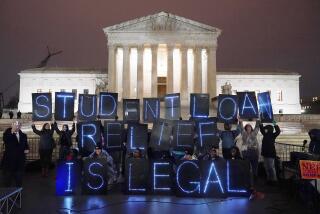The Uncensored War: THE MEDIA AND VIETNAMby Daniel C. Hallin (Oxford University: $22.50; 285 pp.)
All wars produce legends, and the war in Vietnam was no exception. Perhaps the most enduring legend about Vietnam is that the way the war was reported cost the United States a victory.
Robert Elegant, a long-serving Asia expert and a former Vietnam correspondent himself, puts this view succinctly: “For the first time in modern history, the outcome of a war was determined not on the battlefield but on the printed page and, above all, on the television screen . . . never before Vietnam had the collective policy --no less stringent a term will serve--sought, by graphic and unremitting distortion, the victory of the enemies of the correspondents’ own side.”
This accusation has been so widely accepted that only a brave and diligent author would dare to challenge it. Daniel Hallin is such a man. His book--a painstaking analysis of the coverage of Vietnam in the New York Times from 1961-65, and of a sample of the TV network evening news from August, 1965, through the cease-fire in January, 1973, blasts the legend to pieces.
But, in the course of doing so, it goes further. It makes important points about the role of the media in a democratic society, their relationship to government, their duty to readers and viewers, and the dangers we face if we allow any government to pull the media into line by an appeal to patriotism or national interest.
Hallin shows that on an issue as explosive as Vietnam, an undeclared war in a distant, hostile land, with no censorship and few problems of access, the American media--with few honorable exceptions--were remarkably docile.
Far from undermining the Administration, it allowed state secrets of enormous political sensitivity to be contained. It helped the official perspective of the war to dominate the headlines. It propagated official lies. It never questioned American objectives. It kept the American public ignorant of the political tactics, history and programs of the North Vietnamese and the NLF (the Viet Cong). And worse--as in all wars--it helped its government to dehumanize the enemy, banish him from human society, paint him as fanatical, suicidal, half-crazed vermin.
Hallin’s conclusion is a damning one: A great deal of American coverage of Vietnam had no significant value as information about the war--surely one of the great journalistic failures of all time.
But wait a minute. What about Tet? Surely the graphic television and press coverage of the Tet offensive started the swing of public opinion against the war? Quite the contrary. Hallin shows that the reporting of Tet actually rallied Americans behind the war effort. When, for complex social and political reasons, public opinion turned against the war, the media began to reflect it. In short, the media did not lead the swing; they followed it.
The main lesson from this excellent book is a vital and topical one: It is very simple for a government to manage the media in a democracy. All it has to do is offer a clear lead from the top, and the media will follow. The media only begin to question government policy when the government itself appears indecisive.
Hallin suggests that this willingness to accept uncritically what the government says is largely due to the demands of “objective journalism.” Most journalists do not consider it their duty to challenge what their nation’s leaders say because to do so would involve a value judgment and that would not be objective reporting.
As Tom Wicker, who covered the White House for the New York Times at one stage during the Vietnam War, explained: “We had not yet been taught to question the President. . . . We had not been taught by bitter experience that our government, like any other in extremis , will lie and cheat to protect itself.”
More to Read
Sign up for Essential California
The most important California stories and recommendations in your inbox every morning.
You may occasionally receive promotional content from the Los Angeles Times.






